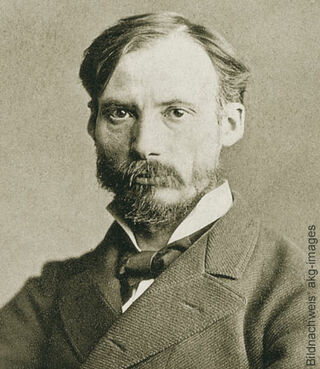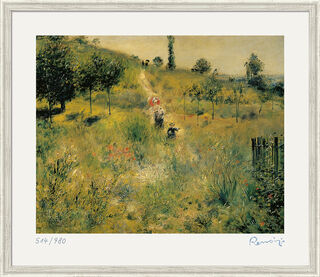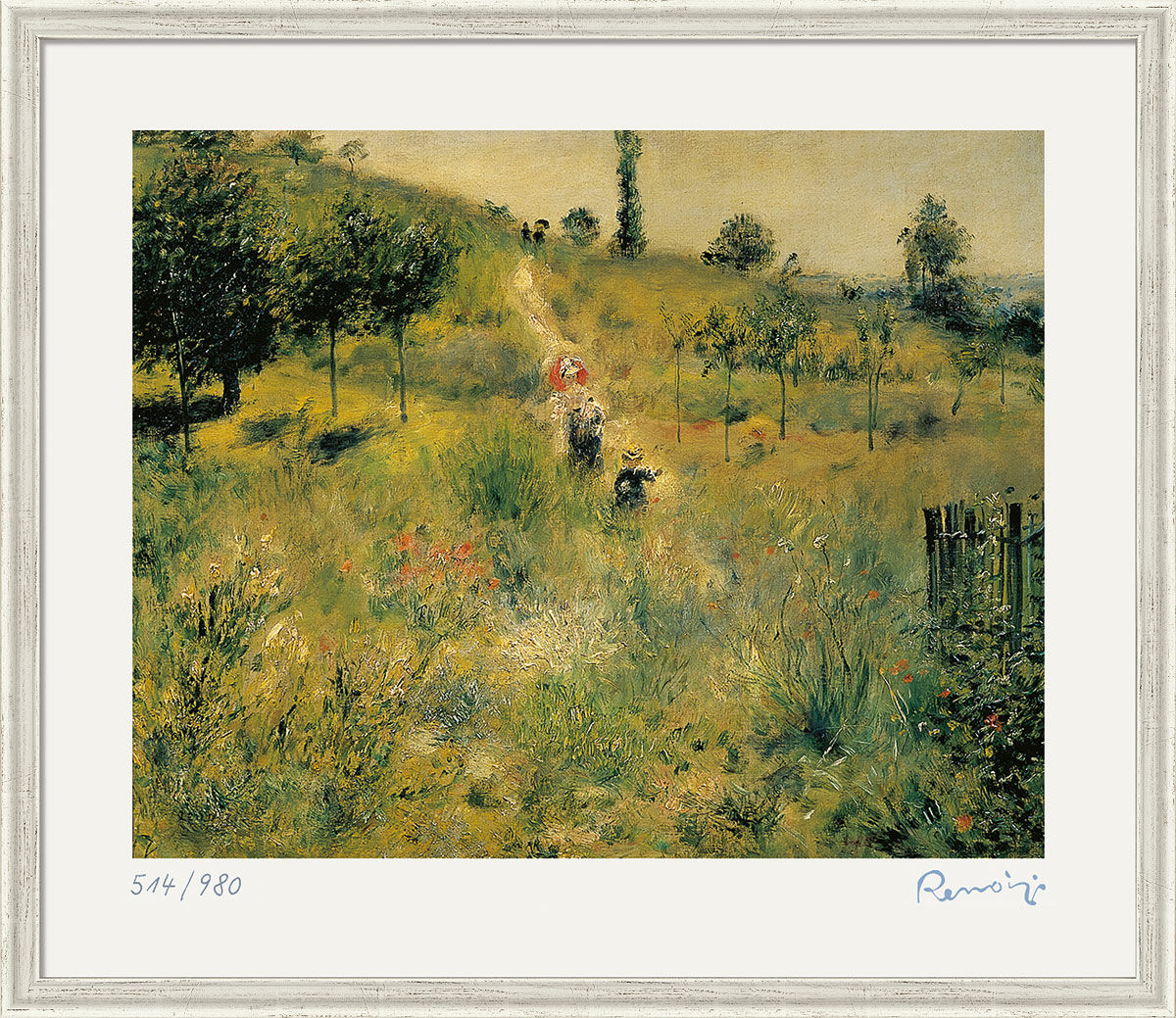Picture "A Path through the Meadows" (1876/77), framed


Picture "A Path through the Meadows" (1876/77), framed
Quick info
limited, 980 copies | hand-numbered | signature | embossing stamp | colour light print on cardboard | hand-glided frame | passe-partout | size 74.2 x 64.2 cm
Detailed description
Picture "A Path through the Meadows" (1876/77), framed
Renoir captures the mood of the moment with incomparable vividness: the play of the sunlit air above the grasses and bushes, the warmth and cheerfulness of summer with an exuberant splendour of colours...
Original: Oil on canvas, Louvre, Paris.
Collotype in 12 colours on 280g natural cardboard. The sensitive facsimile process allows only very limited editions and is mastered today by only a few workshops worldwide. One of them is the Lichtdruckwerkstatt Dresden, which works with the more than 100-year-old collotype equipment of the museum workshop. Limited world edition of 980 copies, numbered by hand and stamped with the artist's signature and the Lichtdruckwerkstatt's embossing stamp. Sheet size 70 x 60 cm. Framed in a hand-glided frame with bevel cut passe-partout. Size with frame 74.2 x 64.2 cm.

About Auguste Renoir
1841-1919
The entire oeuvre of Renoir, who was born in Limoges in 1841, is characterised by his indestructible belief in the life-giving power of nature. The luminous colours of his landscapes, the sensual grace of his paintings of women and young girls bear witness to this with their light cheerfulness.
Initially, Renoir worked as a porcelain painter and studied the work of Antoine Watteau and François Boucher at the Louvre. In 1862, he began studying at the École des Beaux-Arts, then devoted himself to open-air painting in the late 1960s under the influence of the Barbizon School. Together with Claude Monet, Frédéric Bazille and Alfred Sisley, he discovered the special advantages of painting outdoors and maintained close contacts with Camille Pissarro and Paul Cézanne. Together with Claude Monet, he invented the loose brushstroke, with which the constant changing of colours of light can be captured and is the characteristic of Impressionism. In addition to landscape paintings, he also produced portraits of his painter friends and his favourite model Lise Tréhot.
In the summer of 1869, he produced a series of paintings of the restaurant "La Grenoullière", which he frequently visited together with Monet. These light-filled paintings illustrate particularly clearly his distinctive style of fleeting brushstrokes and delicate, light colours that capture the flickering of the air as well as the glistening of the water. In addition, Renoir occasionally expressed his consideration of the works of Courbet and Delacroix through muted tonality and denser brushwork.
However, after a visit to Italy in the 1880s, Renoir abandoned Impressionism. From then on, his focus was no longer on the reproduction of atmospheric moods, but on drawing and composition in the style of Raphael and Ingres.
His late work shows a tremendous power of colour, combined with elements of drawing, which give no hint of his severe rheumatic illness, especially of his hands. With the help of a student, sculptor Maillol, he also created several bronze sculptures during this period.
The most important painter and graphic artist of Impressionism died as a world-renowned artist on 3 December 1919 in Cagnes-sur-Mer.
The field of graphic arts, that includes artistic representations, which are reproduced by various printing techniques.
Printmaking techniques include woodcuts, copperplate engraving, etching, lithography, serigraphy.
The style of Impressionism, which emerged in French painting around 1870, owes its name to Claude Monet's landscape 'Impression, Soleil Levant'. After initial rejection, it began a veritable triumphal procession.
Painters such as Claude Monet, Edgar Degas, Edouard Manet, Auguste Renoir and others created motifs from everyday life, urban and landscape scenes in bright, natural light.
Impressionism can be seen as a reaction to academic painting. The emphasis was not on content with its strict rules of painting structure, but on the object as it appears at any given moment, in an often random cut out. The reality was seen in all its variety of colours in natural lighting. The Studio painting was replaced by open-air painting.
Through the brightening of the palette and the dissolution of firm contours, a new approach to colour emerged. In many cases, the colours were no longer mixed on the palette but side by side on the canvas so that the final impression lies in the eye of the viewer with a certain distance. In "Pointillism", (with painters such as Georges Seurat or Paul Signac) this principle was taken to the extreme.
Outside France, Impressionism was taken up by painters such as Max Slevogt, Max Liebermann and Lovis Corinth in Germany, and by James A. M. Whistler in the United States.
However, Impressionism was only expressed to a limited extent in the art of sculpture. In the works of Auguste Rodin, who is considered one of the main representatives, a dissolution of surfaces is evident, in which the play of light and shadow is included in the artistic expression. Degas and Renoir created sculptures as well.


